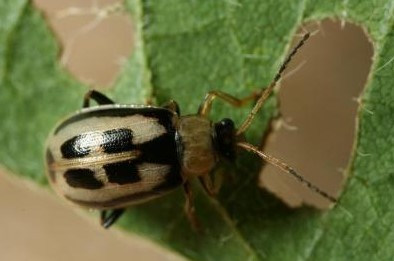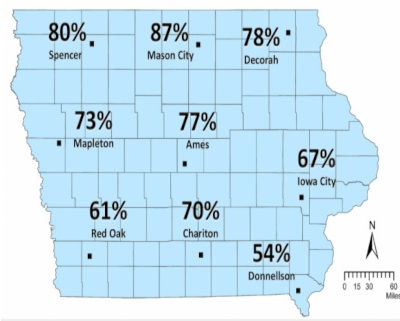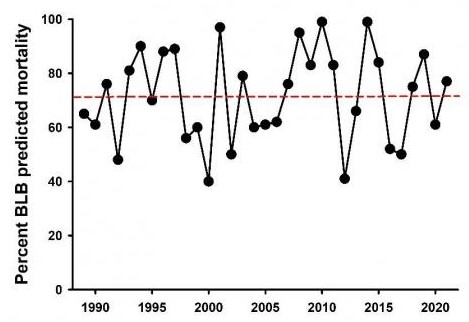By Ashley Dean and Dr. Erin Hodgson
Bean leaf beetle adults (Photo 1) are susceptible to cold weather and most will die when air temperatures fall below 14°F (-10°C). However, they have adapted to winter by protecting themselves from harsh temperatures under plant debris and loose soil. Each spring, adult beetles emerge from their overwintering habitat and migrate to available hosts, such as alfalfa, tick trefoil, and various clovers. As the season progresses, bean leaf beetles move to preferred hosts, like soybean. While initial adult activity can begin before soybean emergence, peak abundance often coincides with early-vegetative soybean.

Photo 1. Adult bean leaf beetle.
An overwintering survival model developed by Lam and Pedigo from Iowa State University in 2000 is helpful for predicting winter mortality based on accumulated subfreezing temperatures. Predicted mortality rates in Iowa are variable for the 2020-2021 winter, ranging from 54-87% (Figure 1). Mortality was highest in northern Iowa (78-87%); the average mortality rate across Iowa is 72% for the 2020-2021 winter.

Figure 1. Predicted overwintering mortality of bean leaf beetle based on accumulated subfreezing temperatures during the winter (1 October 2020 – 15 April 2021).
These mortality predictions have been tracked since 1989 with Marlin Rice. The predicted mortality of bean leaf beetle in central Iowa was 77%, about 5% higher than the 30-year average of 71.5% (Figure 2). It is important to remember that insulating snow cover and crop residue can help protect bean leaf beetle from harsh air temperatures, and variable snow and residue cover is not accounted for within the model. Fluctuating temperatures can negatively influence spring populations.

Figure 2. Predicted bean leaf beetle mortality by year for central Iowa; the red dashed line indicates the average mortality rate (71.5%).
Although overwintering beetle populations are expected to be lower than last year, it is important to scout for this pest. Consider scouting soybean fields, especially in southern Iowa, if:
- Soybean is planted near alfalfa fields or if the field has the first-emerging soybean in the area. Overwintering adults are strongly attracted to soybean and will move into fields with emerging plants.
- Fields are planted to food-grade soybean production or are seed fields where reductions in yield and seed quality can be significant.
- Fields have a history of bean pod mottle virus.
Bean leaf beetles are easily disturbed and will drop from plants and seek shelter in soil cracks or under debris while scouting. Sampling early in the season requires you to be “sneaky” to estimate actual densities. Although overwintering beetles rarely cause economic damage, their presence may be an indicator of building first and second generations later in the season. More detailed information about bean leaf beetle and bean pod mottle virus are available.
Source : iastate.edu